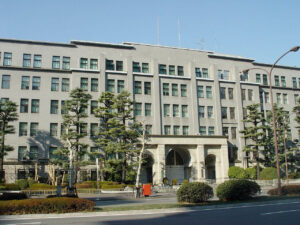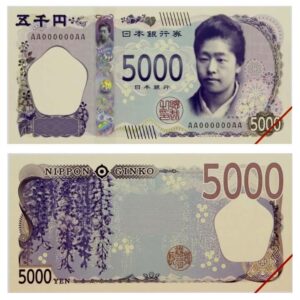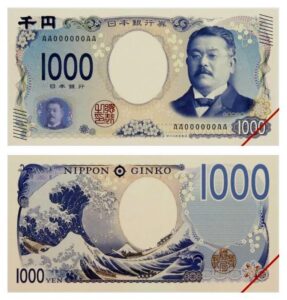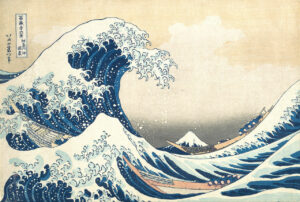The Japanese Ministry of Finance announced on April 9, 2019 that the Bank of Japan will embark on a programme for the issuance of new banknotes which will incorporate new security features and designs, along with the inclusion of new prominent Japanese personalities featured on the front side.

The banknotes included in the new series are the 10,000, 5000 and 1000 Yen denominations, the 2000 Yen banknote introduced in 2000 will not be affected. Along with this announcement, the Finance Ministry released information about the currently circulating 500 Yen coin and unveiled a design which corresponds to the Country’s change in the Imperial era that began on May 1, 2019. The current series of banknotes, classified as the “E series” and initially introduced in 2000 will be replaced with the series designated as “F” and expected to begin circulating in 2024 at the earliest.
New Security Features of Yen Banknotes
As part of the re-design, the notes will also incorporate new-generation 3-D holograms and other anti-forgery technology which will be announced at a later date. The images included in the holograms will have the effect of appearing to move as the angle changes. It’s believed this is the first time this technology is being incorporated in banknotes anywhere in the world. As with the current series, dimensions will remain the same with the western numerals denoting their face value will increase noticeably on the obverse or front side and reverse. The number of digits in the note’s serial numbers will increase from 9 to 10.

The new 10,000 yen note will feature famed industrialist Eiichi Shibusawa (1840–1931) A prominent figure of Japanese industry from the 19th through early 20th century, he is considered the “father of Japanese capitalism”. Following the Meiji Restoration in 1867, Shibusawa worked with the finance ministry before becoming an independent businessman. He is also noted as having established and developed more than 500 businesses. Among them was Japan’s first commercial bank, which eventually became Mizuho Bank. He also credited with having created the predecessors of the Tokyo Stock Exchange and the Tokyo Chamber of Commerce.

The reverse side includes a depiction of the Tokyo Rail Station in Chiyoda City (Marunouchi Station Building) designed by Tatsuno Kingo (1854 – 1919) and completed in 1914, this historical building that has been popularly known simply as the “red Brick Station Building” and represents one of the finest examples of architecture during the Meiji and Taisho periods. Partly destroyed in the war, the complete restoration work was finally completed in 2012.

The new 5000 Yen banknote is proposed to feature Tsuda Umeko (1864-1929) In 1871, she is remembered to have been one of the first female students to take part in the Iwakura Mission, a Japanese diplomatic initiative to the United States and Europe conducted between 1871 and 1873 by leading statesmen and scholars of the Meiji period. In 1900, she established the Women’s College of English (now Tsuda University) and worked on modern women’s higher education.
The reverse side will depict a collection of wisteria flowers, a species of flowering plant in the pea family Fabaceae, native to Japan. A traditional fabric known as “Fujifu” is made from wisteria stalks and is said to be the oldest known fabric in Japan, dating from the prehistoric Jomon period.

The new 1000 Yen banknote will portray Kitasato Shibasaburō (1853-1931). A prominent Japanese physician and bacteriologist, he is remembered as the co-discoverer of the infectious agent of the bubonic plague in Hong Kong in 1894. Kitasato was nominated for the first annual Nobel Prize in Physiology or Medicine in 1901 and in 1914 he founded the Kitasato Institute, the forerunner of Kitasato University which he headed for the remainder of his life.

The reverse side will include the well-known artwork print entitled “The Great Wave off Kanagawa”. The depiction is a woodblock print by the Japanese artist Hokusai and was published sometime between 1829 and 1833 during the late Edo period as the first print in Hokusai’s series “Thirty-six Views of Mount Fuji”. This print is Hokusai’s most famous work, and one of the most recognisable works of Japanese art in the world.

As part of the revised currency programme announced, the Ministry of Finance have launched proposed designs and revisions for the country’s largest-denominated circulation coin, the 500 Yen. With the enthronement of a new Emperor and the introduction of the new Imperial era of Reiwa, Japanese coins will include these changes which mean the inclusion of traditional characters denoting the new Imperial era.
The most significant change aside from the characters denoting the Era of Reiwa, will be the coin’s change to that of a bi-metallic composition. Also included in terms of updated security features will be the addition of micro-lettering along the inner edges which will be shown as “JAPAN” and the coin’s face value of “500 YEN”. The outer ring will be comprised of an aluminium-zinc golden colour with a clad composite inner disc of copper-nickel, with a silver coloured effect. The coin’s diameter will remain at 26.5 mm and weigh 7.1 grams. The first coins to be released with these new changes will be in 2021 – the coins will reflect the third year of the Reiwa era. The Ministry of Finance are not proposing any obverse or reverse design change for the new coin’s release beginning in 2021.
The author, Michael Alexander is president of the London Banknote and Monetary Research Centre.
For additional information on Japanese banknotes, please visit the website of the Bank of Japan.
Japan has repeatedly had to deal with counterfeit 500 yen coins in the past. The new design and security features might help fight this problem.
The Encyclopaedia Britannica offers additional information about industrialist Eiichi Shibusawa and bacteriologist Kitasato Shibasaburo.
On May 1, 2019, former Crown Prince Naruhito succeeded his father Akihito as Emperor of Japan initiating the so-called Reiwa Period. The Guardian explains what this name means and how it was chosen.




